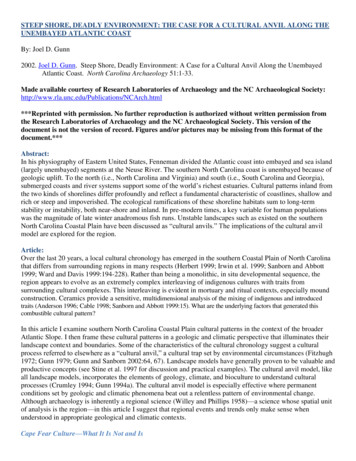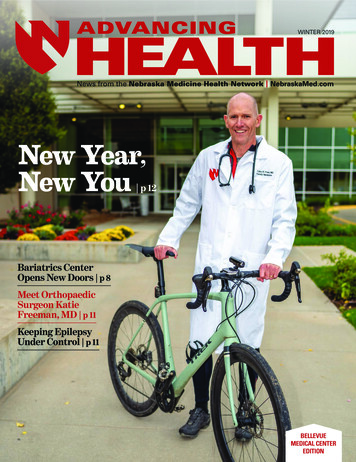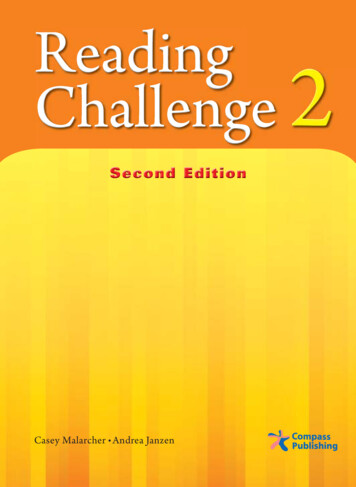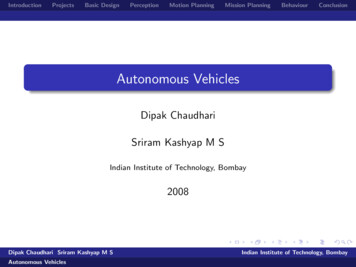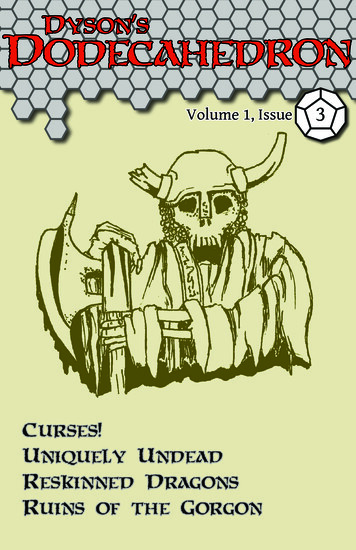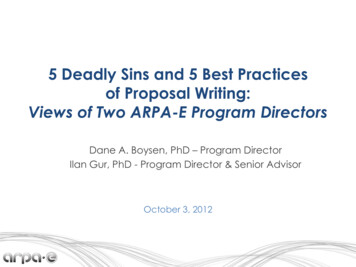
Transcription
5 Deadly Sins and 5 Best Practicesof Proposal Writing:Views of Two ARPA-E Program DirectorsDane A. Boysen, PhD – Program DirectorIlan Gur, PhD - Program Director & Senior AdvisorOctober 3, 2012
ARPA-E Overview2
History of ARPA-E20112009-20102007FY2011 Budget2012FY2012 Budget( 275M)( 180M)AmericanRecovery &Reinvestment ActAmerica( 400M)Competes Act2006Rising Above theGathering Storm(National Academies)Arun Majumdar1st Director33
The ARPA-E MissionCatalyze and support the development oftransformational, high-impact energy technologiesEnsure America’s National security Economic security Energy security Technological leadReduceImportsImproveEfficiencyReduceEmissions4
What makes an ARPA-E program?1. Impact High impact on ARPA-E mission areasCredible path to marketLarge commercial application2. Transform Challenges what is possibleDisrupts existing learning curvesLeaps beyond today’s technologies3. Bridge Translate science into breakthrough technologyNot researched or funded elsewhereCatalyzes new interest and investment4. Team Best-in-class peopleCross-disciplinary skill setsTranslation oriented5
5 Deadly Sins6
5 Deadly Sins of an ARPA-E proposalThou shall not submit a proposal that is ncoherent5.Indefinite7
5 Deadly Sins of an ARPA-E proposal Insignificant: The proposal does not draw a clear connection showingthat a successful project would lead to significant impact on on ofARPA-E's mission areas8
5 Deadly Sins of an ARPA-E proposal Insignificant: The proposal does not draw a clear connection showingthat a successful project would lead to significant impact on on ofARPA-E's mission areasOur advanced block copolymer membranetechnology will dramatically improve energyefficiency of coffee filtering: 10X more energy efficient than state-of-the-artcoffee filtration Impact over 100 million coffee drinkers in US9
5 Deadly Sins of an ARPA-E proposal Insignificant: The proposal does not draw a clear connection showingthat a successful project would lead to significant impact on one ofARPA-E's mission areasOur novel hydrogel technology will allow for a newgeneration of super biodegradable diapers: Exposing diaper to uv light activates ability to fullydissolve in water in 30 seconds, vs. the 300 yearbiodegradation time scale of conventional diapers Will save 18 billion diapers from entering USlandfills each year10
5 Deadly Sins of an ARPA-E proposal Indistinguishable: The proposal fails to communicate how the proposedapproach is innovative and differentiated from commercial or emergingtechnologies being funded or developed elsewhere.11
5 Deadly Sins of an ARPA-E proposal Incremental: The proposal describes a low-risk approach that seemsmore like an engineering development project vs. disruptive R&D12
5 Deadly Sins of an ARPA-E proposal Incoherent: The proposal reads as though several disparate sections bydifferent team partners were written independently and "stapled"together -- lacks cohesive vision/teaming13
5 Deadly Sin" of an ARPA-E proposal Indefinite: The proposal generically describes ideas being proposedwithout any detail on the technology, and/or provides no justificationsfor the claims that are made.Next generation vehicle allows for flexible,energy efficient time travel Allows for 10X more efficient time travel toany date and place in the history of theuniverse Technology leverages novel proprietarytechnology from Doc and McFly Industries,Inc. Technology has been validated at proof-ofconcept scale by D&M Industry advisors,including several nobel laureates14
5 Deadly Sin" of an ARPA-E proposal Indefinite: The proposal generically describes ideas being proposedwithout any detail on the technology, and/or provides no justificationsfor the claims that are made.Next generation vehicle allows for flexible, energyefficient time travel Allows for 10X more efficient time travel to anydate and place in the history of the universe Next generation flux capacitor based onproprietary hafnium alloy is the key enablingtechnology Capacitor placement within metallic vehicle bodyperturbs the flux dispersal field, allowing smoothpassage through the space-time continuum (seereferences 3-8) Time travel requires 1.21 Jigawatt-hours ofelectrical power, with allows for 10x efficiency gainas validated via the mass/energy balance outlinedin Table 315
5 Deadly Sins of an ARPA-E proposal1.Insignificant: The proposal does not draw a clear connection showingthat a successful project would lead to significant impact on on ofARPA-E's mission areas2.Indistinguishable: The proposal fails to communicate how the proposedapproach is innovative and differentiated from commercial oremerging technologies being funded or developed elsewhere.3.Incremental: The proposal describes a low-risk approach that seemsmore like an engineering development project vs. disruptive R&D4.Incoherent: The proposal reads as though several disparate sections bydifferent team partners were written independently and "stapled"together -- lacks cohesive vision/teaming5.Indefinite: The proposal generically describes ideas being proposedwithout any detail on the technology, and/or provides no justificationsfor the claims that are made.16
The 6th Deadly SinThou shall not submit a proposal that is INSINCERE17
5 Best PracticesPlease note that these “Best Practices” are primarily targeted at theConcept Paper stage of the ARPA-E funding application process.18
ARPA-E Program Development CycleTechnology to MarketTransitionProgramHandoffOngoing TechnicalReviewEstablishWorkshopEnvisionContract Negotiation& AwardsProject SelectionProgram Conception(Idea / Vision)Program DevelopmentExecuteEngageRebuttalMerit Review ofProposalsMerit Review ofConcept PapersProgramApprovalFOA Development& Issuance19
Literature ExampleRechargeable Solid State Fluorine Ion BatteryWe propose a rechargeable fluorine ion (F-ion) battery that uses a solid state fluorine ion conductor (e.g. La 0.9Ba0.1F2.9) withmetal fluoride electrodes, such as the Ce//CuF2 couple. Solid state F-ion batteries with electrodes such as Ce//CuF2electrodes have a theoretical energy density of 792 Wh/kg (2.9 V) that compares favorably to state-of-the-art Li-ion batteriessuch as LiC6//CoO2 at 568 Wh/kg (3.6 V). To date, we have demonstrated that the Ce//BiF3 electrode couple isrechargeable (Figure 2). Several key challenges remain in demonstrating the viability of a F-ion battery including: 1)decreasing electrolyte resistance losses, 2) increasing electrode material utilizations, and 3) maintaining capacity over longcycle life. In the proposed work these challenges will be addressed by 1) decreasing the electrolyte thickness and dopingthe electrolyte to increase conductivity, 2) engineering electrode microstructure to better utilize electrode material; and 3)selecting optimal electrode materials for enhanced cyclability.Cu3Cu 6F 6e 3CuF2 eLFCeF3La0.9Ba0.1F2.92CeF3 6e 6F 2Ce–Figure 1. Diagram F-ion battery with Ce//CuF2 electrodes.Figure 2. Preliminary charge-discharge cycles at 10um/cm2 and 150 C of a Ce//BiF3 cell.Reference: MA Reddy, M Fichtner. J. Mater. Chem. 21:17059, 201120
5 Best Practices1.Describe the technological innovation in the first sentence21
5 Best Practices2.Provide a visual aid describing technology directly after the firstparagraph22
5 Best Practices3.Back-up claims with data or strong scientific rationale23
5 Best Practices4.Compare proposed technology to the state of art24
5 Best Practices5.Clearly identify the technical challenges and approaches to solving them25
Summary of Best Practices1.2.Describe the technological innovation in the first sentence3.4.5.Back-up claims with data or strong scientific rationaleProvide a visual aid describing technology directly after the firstparagraphCompare proposed technology to the state of artClearly identify the technical challenges and approaches to solvingthem26
The Heilmeier Catechism George H. HeilmeierDARPA Director (1975-1977) What are you trying to do? Articulateyour objectives with absolutely no jargon.How is it done today, and what are thelimits of current practice?What’s new in your approach and whydo you think it will be successful?Who cares?If you’re successful, what difference will itmake?How much will it cost?How long will it take?What are the midterm and final “exams”to check for success?
Questions?Please use the WebEx Q&A box to submit yourquestions.28
Rising Above the Gathering Storm (National Academies) 2007 America Competes Act 2009-2010 American Recovery & Reinvestment Act ( 400M) History of ARPA-E 3 2012 FY2012 Budget ( 275M





